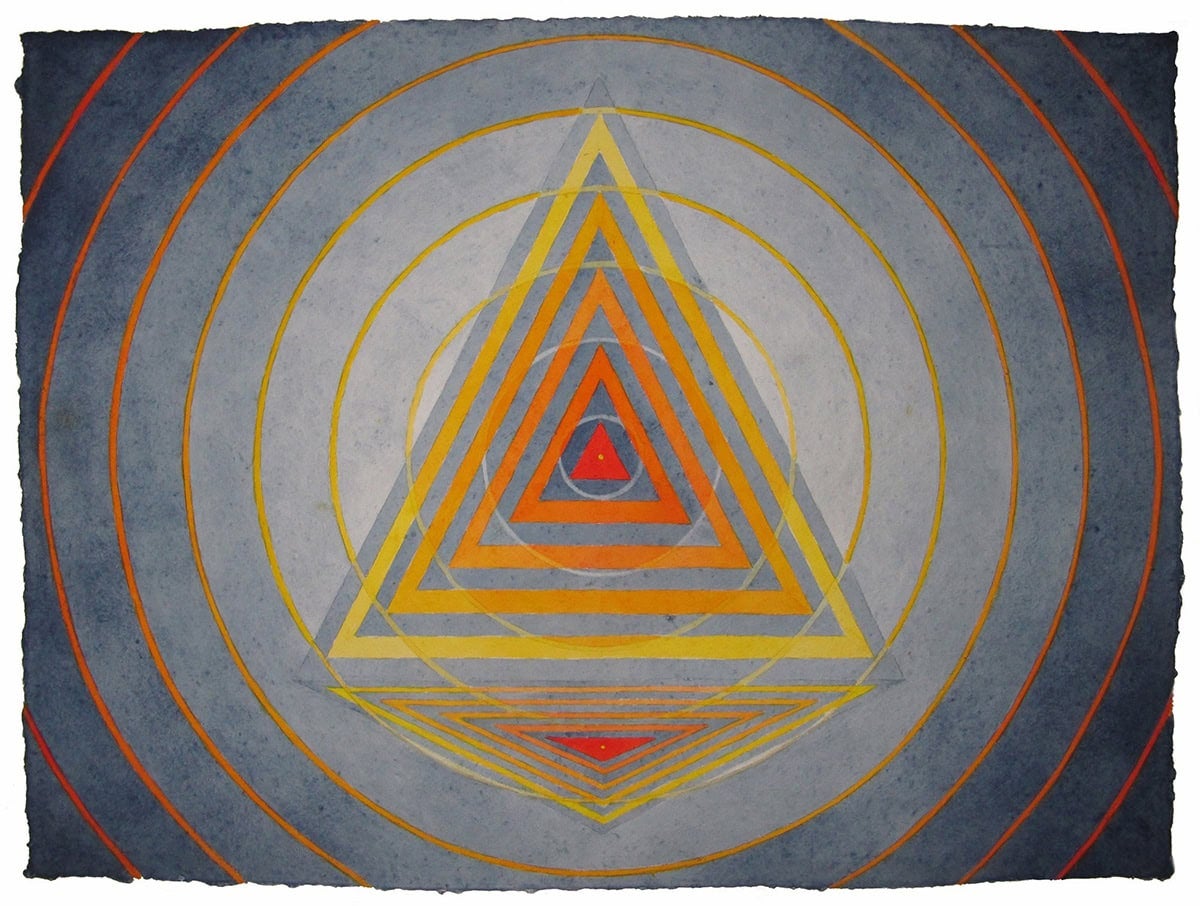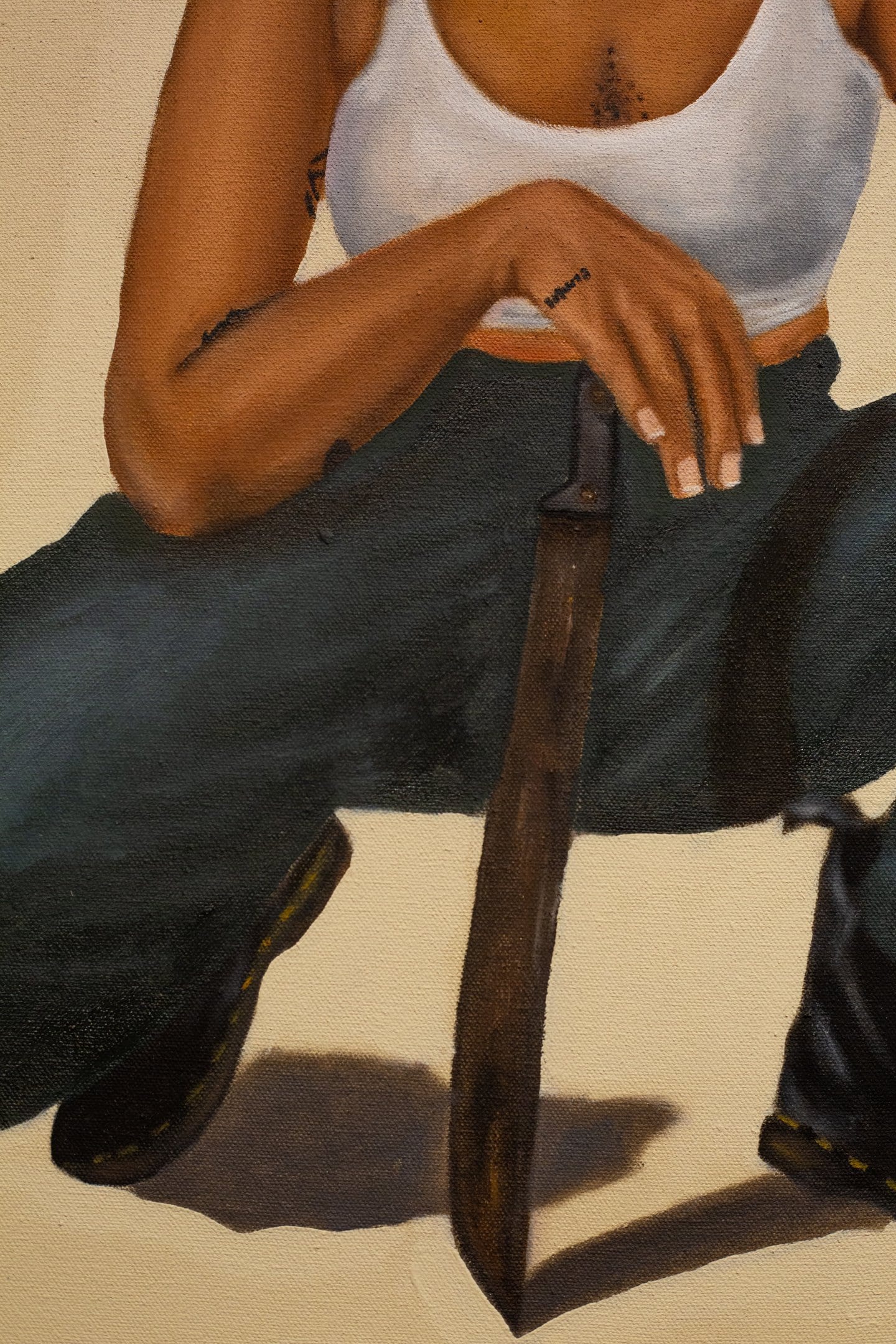
Atlanta painter Don Cooper’s new series of paintings Fire Within is a contemplative parable told through color and geometry. The series extends Cooper’s lasting visual exploration of ineffable truths and regularities, fixing that meditative gaze on the will to create.
On view at Sandler Hudson Gallery through May 7 [extended through May 14], the paintings — the majority watercolor on paper, feature recurring symbols in color palettes ranging from demurely cool to exuberantly warm tones. In a third of the group, pallid blues, diluted reds, and earthy sage greens and ochres anticipate the incendiary oranges, reds, and pinks of an inspired conflagration in other works. Expressive qualities aside, color choices within individual works and across the series are unexpected, and help establish an internal logic clear enough to read as narrative content.
The series’ most obvious recurring form is the triangle, which for Cooper symbolizes a fire or passion for making things. Circles and the bindu, a yogic symbol of the universe in its unmanifested state, also appear in nearly all paintings on view. Through repetition, deviation, and deft handling of composition and color, the triangle becomes the series’ protagonist, seeming to exhibit intention, habits of motion, and persistence through time.
In nearly three-fourths of the paintings, an equilateral triangle inscribed inside a circle emanates from the bindu at center. Cooper varies this structure — and achieves occasional optical illusions — through his extensive color palette and, in about half of the group, by incorporating additional concentric circles. These additional lines disrupt the inner, circumscribed circle’s visual dominance. Here, as circles radiate concentrically they shift weight outward until the circle enclosing the triangle can no longer maintain its boundary; interstitial spaces and new colorful forms emerge.
Free from equilateral constraint, vertices venture beyond the supports’ corners; color planes formerly washed out explode in triumphant degrees of gradation and saturation. Seven paintings of Fire Within take these liberated shapes, “giving form,” in Cooper’s words, “to visions that honor creative passion.” Upon defying the circle, the triangles burst with energy and, owing to his experienced handling of composition and color, seem to exceed materiality and soar to Platonic heights.

In our correspondence, Cooper noted that the paintings of Fire Within grew “out of a feeling and curiosity about the ongoing fire or passion creative people have that drives them to keep making things.” For years, he thought “‘Inner Fire,’ the name of a chapter from a book about India’s holy men … would be an inspiring title for a painting.” Initially imagining more illustrative paintings, Cooper concluded that abstraction was preferable to figuration.
In Cooper’s paintings of the last decade, such as the Bindu and Path Within series, abstraction recalls massive geologic and celestial structures, and conjures rumination on universal laws and forces. Having worked with the circle in prior bodies of work, he “instinctively positioned the triangle inside it, and later discovered during research that the triangle is actually a symbol for fire in several cultures.” Indeed, traditions across millennia, such as the ancient alchemists, Pythagoreans, and Neo-Platonists, associated the upward pointing triangle with fire’s lightness, ascension, and energy. By tapping into that instinctual resonance with geometric form, Cooper develops a symbolic language that visualizes the creative will’s various expressions: ennui, repression, renunciation, inspiration, resolve, and exhilaration. Fire Within, then, extends his continuing visual meditation on truths that slip language’s grasp from envisioning macrocosmic or fundamental forces to reflectively imagining how creativity manifests.
If color, spatial relationships, and abstract content left any doubt about this inward focus, the choice of handmade paper as substrate reinforces the series’ personal dimension. In 1998, Cooper purchased a few small sheets of handmade paper from a women’s cooperative in Jaipur, India. “Each piece of paper,” he recalled, “was like a minimalist sculpture.” He was able to find a stateside source of a similar paper that he has used for years. Fond of the paper’s irregular handmade shape and forgiving texture — “bits of hair and colorful threads can be found within the surface” — Cooper avoids presoaking, stretching, and taping. Using rulers, a handmade compass, and paper stencils, he defines the composition’s initial structure, the bones of which remain legible here and there. From there, his method of “finding spatial relationships with multiple transparent layers of diluted pigment,” along with the use of tools, yield washes laid precisely upon paper tolerant of large amounts of liquid color while still drying flat. Despite their geometric content’s insistent lines and neat execution, they maintain a painterly essence, which intensifies in works that most challenge the default arrangement. Material qualities further reinforce Cooper’s symbolic language when the paper’s proportions become discernibly rectangular, deviating from the series’ standard approximate square. The triangle becomes isosceles as base vertices stretch horizontally with the rectangular support.
Prior series have also included a self-reflexive component articulated through specific material and technical choices. Path Within, for instance, includes paintings made on nonabsorbent, synthetic paper, which records the painter’s interaction with the medium through time. Completed works are circular fields teeming with patches of pigment, reminiscent of both a slide seen through a microscope and of faraway stellar phenomena. Though the painter’s action is visible, which marks a departure from previous examples’ pristine execution, the objects still feel cosmic, as if visualizing primordial life, geologic formations, or the surface of a star. Fire Within pushes this shift, drawing Cooper’s exploration of unutterable universal regularities inwardly to illustrate and venerate the creative will.




